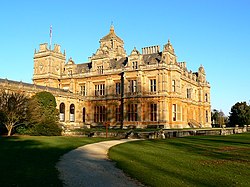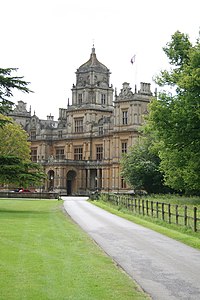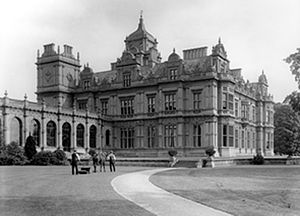Westonbirt House
| Westonbirt House | |
| Gloucestershire | |
|---|---|
 Westonbirt House Girls' School | |
| Location | |
| Grid reference: | ST86428962 |
| Location: | 51°36’19"N, 2°11’51"W |
| Village: | Tetbury |
| History | |
| Built 1863-70 | |
| For: | Robert Stayner Holford by Lewis Vulliamy |
| Country house | |
| Information | |
| Condition: | Converted to school |
Westonbirt House is a country house in Gloucestershire, about three miles south-west of Tetbury. It belonged to the Holford family from 1665 until 1926. The first house on the site was an Elizabethan manor house.
The Holfords replaced the Elizabethan house with a Georgian house, and then Robert Stayner Holford, who inherited Westonbirt in 1839, replaced that house between 1863 and 1870 with the present mansion, which was designed by Lewis Vulliamy. He also remodelled the gardens, diverted the main road and relocated the villagers.
The house is constructed of high quality ashlar masonry on a grand scale. The exterior is in an Elizabethan style, with a symmetrical main block and asymmetric wings, one of them containing a conservatory. The interiors are in a sumptuous classical style. The house was fitted with the latest technology such as gas lighting, central heating, fireproof construction and iron roofs. It is now a Grade I listed building.[1]
Extensive formal terrace gardens were created around the house and 25 acres of ornamental woodland were planted in the 19th century.
Since 1928, the house has been occupied by the girls' boarding school Westonbirt School. Westonbirt House is open to the public on certain days, and the gardens are open more frequently. The house is also licensed to hold weddings.
The Holfords
George Pater Holford inherited a mansion at Westonbirt from his father which was the original manor, built in the reign of Elizabeth or the early part of the time of James I.[2] In 1818 he demolished this house and had a new house built in 1823.[3]
George’s son, Robert Stayner Holford (born in 1808) graduated from Oriel College in 1829 at the age of 21,[4] and in the same year the arboretum on the Westonbirt Estate was begun, in which project Robert played a significant role. In 1838 he inherited his uncle's fortune of over one million pounds and in the following year his father died and he became the owner of Westonbirt House. He began collecting paintings and books for what was to become the famous "Holford Collection". To accommodate this collection he built Dorchester House in Park Lane, London between 1851 and 1853 where he employed Lewis Vulliamy as the architect.[5]
Between 1863 and 1870, Robert built the present Westonbirt house, which was reputed to be one of the most expensive houses constructed in the Victorian era. Aftwer retirement from Parliament, he continued to collect plants for the garden at Westonbirt House and also for the arboretum. His son George also developed an interest in gardens and plants and assisted his father with this work.
In 1875 Charles Gayard, a French diplomat, visited Westonbirt and gave an account of his experience as follows.
- This morning I have lost no time. Sometimes Mrs Holford, sometimes Evy, took me about the house, which surpasses in magnificence any that you know. There is a hall, a sort of conservatory three stories high, something like the great apartments of Louis XIV. The most original room in the house is the one painted by Mrs Holford, in a bizarre fanciful style, something between Delacroix landscape and Rouen pottery.
- After luncheon my friends took me on a pony chaise, across the beauties of the park to the keeper's lodge. I saw conservatories without end, then a lake, a bit of a wild, heaps of rocks that it seems have been newly brought there. And the lake too is a thing of yesterday. The pheasants were so thick we fairly trod on them. At last we reached the Head-keepers's lodge, and saw a pack of thirty spaniels with legs short enough to make the rabbits dance for joy.
The garden at Westonbirt House and the Arboretum continued to expand and in 1886 an extensive article was written about it in The Garden. This said that "Mr Holford's aim has been to create variety without confusion, informality and picturesqueness without losing sight of that polish in the vicinity of the mansion which must always be regarded as in accordance with correct taste."[6]
In February 1892, Robert died at Dorchester House.
The house and estate were further cultivated by George Holford, son and heir to Robert, after inheriting the estate, and Dorchester House, in 1892. He evinced a passion for gardens and orchids so he devoted much of his time to his property at Westonbirt.[7] The Times made the following comment about him.
- "He was indeed, one of the most successful amateur gardeners of the time, and though famous as a grower of orchids, amaryllids and Javanese rhododendrons, his garden and estate show a wide catholicity of taste. The arrangement of the many rare and exotic trees there and the skilful use of evergreen species as background and to provide the shelter so needful in a cold district like the Cotswolds, have rarely been equalled; there is no crowding of the trees; each is able to show its true form and all have been well cared for. On few estates has the autumnal colouring of deciduous tress been so cleverly used by harmony and contrast, as, for instance, in the planting of Norway maples and glaucous Atlantic cedars."[8]
Country Life magazine wrote extensive articles about Westonbirt Gardens and Arboretum in 1905[9] and again in 1907[10] when George was the owner of the estate. They outlined in detail the beauty of the gardens and made the comment.
- "Captain Holford has carried on the work in the same spirit and with the same tradition (as his father) and Westonbirt is now more luxuriant and more beautiful than the late Mr Holford ever knew it. The gardens have been planted not to give an effect for one season only but to be invested with beauty at every time of the year."[11]
After George’s death, the main part of the estate passed to his nephew, the 4th Earl of Morley.[12]
Arboretum
- Main article: Westonbirt Arboretum
Robert Stayner Holford, the rebuilder of Westonbirt, also founded the Westonbirt Arboretum on former common downland across the road from the house, a mile away. The arboretum was developed over the next few decades by him and his son Sir George Lindsay Holford. Since the younger Holford did not have children, the house and arboretum passed to his eldest sister's son the 4th Earl of Morley, who sold the house by 1928. The family gave the arboretum to the nation in 1956.[13]
The estate today
The gardens and surrounding parkland, together with the arboretum, were listed Grade I on the Register of Historic Parks and Gardens of special historic interest in 1986.[14] Westonbirt School and its preparatory school are on the site. The school's leisure centre and golf course can be accessed by the public.
Westonbirt Arboretum is managed by the Forestry Commission and is open to the public on a regular basis.
Outside links
| ("Wikimedia Commons" has material about Westonbirt House) |
- Holford Trust
- National Heritage List 1235736: Westonbirt House
- [1] – A History of the County of Gloucester - Volume 11 : {{{2}}} (Victoria County History)
- Weston Birt described in Views of the seats of noblemen and gentlemen in England, Wales, Scotland and Ireland, Second Series, Volume III, by John Preston Neale, 1826
References
- ↑ National Heritage List 1235736: Westonbirt House with south terrace
- ↑ 'Jones views of the seats of noblemen and Gentlemen of England, Wales, Scotland and Ireland', Jones and Company, 1829, London.
- ↑ Register of Parks andGardens of Special Historic Interest, (1999) 'Westonbirt, Gloucestershire, Cotswold' Ref No 1426.
- ↑ Dod, Robert (1857) 'The Parliamentary Companion for 1857', Whittaker and Company, London, p. 208.
- ↑ Cancellor, E. B. (1908) 'The private Palaces of London: Past and Present', Kegan Paul, Trench, Trubner and Co., London, p. 250.
- ↑ Goldring, W., 'Westonbirt', The Garden: and Illustrated weekly journal of gardening in all its branches", 20 Feb 1886, p. 157.
- ↑ Morris, L. A. 1988, "Rosenbach Abroad: In pursuit of Books in Private Collections", Rosenback Museum and Library, Philadelphia, p. 16.
- ↑ "The Times", 13 September 1926, p. 15.
- ↑ "Country Life', 25 March 1905, p. 414-423.
- ↑ "Country Life", 22 June 1907, pp. 911–917.
- ↑ "Country Life", 22 June 1907, pp. 911–2.
- ↑ UKForestry Commission, "History of the Collection" http://www.forestry.gov.uk/forestry/INFD-6XDCU8, (accessed 15 January 2010)
- ↑ Christopher Stocks. "Gardens: Log On", The Independent on Sunday, 22 May 2005.
- ↑ National Heritage List 1000457: Westonbirt: parks and gardens
- Girouard, Mark: 'The Victorian Country House' (1979) ISBN 0-300-02390-1
- Mander, Sir Nicholas, Bt: 'Country Houses of the Cotswolds' (Aurum Press, 2008)

